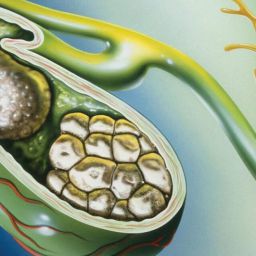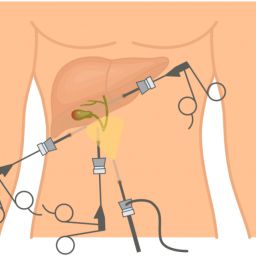
1. Immediate Post-Surgery Recovery (Day 1 to 3)
The first few days after gallbladder surgery are crucial for healing. During this time, patients are monitored in the hospital to ensure that they are recovering well and to manage any potential complications. Here’s what typically happens during this early stage:
Laparoscopic Cholecystectomy Recovery
- Hospital Stay: After laparoscopic surgery, patients usually stay in the hospital for 1 to 2 days. The procedure is minimally invasive, and most patients are able to walk and move around shortly after the surgery. However, some discomfort, including bloating, nausea, and mild abdominal pain, is common during the first 24 hours.
- Pain Management: Postoperative pain is typically managed with prescribed pain medications. Most patients experience mild to moderate pain around the incisions, but this can usually be controlled with pain relief.
- Drainage: Some patients may have a small drainage tube in place to help remove excess fluids or bile. This will be removed before discharge.
- Diet: Patients are often advised to start with a clear liquid diet and gradually transition to soft foods. Eating solid foods too soon can cause digestive discomfort, so it’s essential to follow the doctor’s dietary instructions.
Open Cholecystectomy Recovery

- Hospital Stay: Open surgery usually requires a longer hospital stay of 3 to 5 days due to the more invasive nature of the procedure. The larger incision requires more time to heal, and patients may experience more postoperative discomfort.
- Pain Management: Pain management is more critical after open surgery, as the larger incision causes more pain and discomfort. Stronger pain medications may be prescribed.
- Post-Surgical Care: After open surgery, patients are generally advised to limit their physical activity for a longer period. Careful attention to the wound and signs of infection is required.
2. Short-Term Recovery (Week 1 to Week 2)
During the first two weeks after gallbladder surgery, patients are still recovering and adjusting to life without a gallbladder. The focus during this stage is on managing pain, resuming light activities, and ensuring that the body is healing properly.
Pain and Discomfort
- Most patients will experience some mild to moderate pain, particularly around the incision sites. This pain should gradually subside within the first two weeks. Over-the-counter pain medications may be recommended, but stronger medications may still be prescribed if necessary.
- For laparoscopic surgery, the pain is usually less severe, but some discomfort may persist, especially due to the gas used to inflate the abdomen during the procedure.
- Patients who have undergone open surgery may experience more significant pain, which may take longer to subside.
Physical Activity
- Light activities, such as walking, are encouraged to promote circulation and reduce the risk of complications like blood clots. However, heavy lifting and strenuous exercises should be avoided during this time.
- In the case of laparoscopic cholecystectomy, patients can usually return to work or normal activities within 1 to 2 weeks, depending on how they feel. However, it is essential to avoid lifting heavy objects for at least 4 to 6 weeks.
- For those who have undergone open cholecystectomy, the recovery time for resuming normal activities may take a bit longer—usually 4 to 6 weeks.
Dietary Adjustments
- After gallbladder removal, the body may have difficulty processing fatty foods due to the absence of the gallbladder, which is responsible for storing bile. As bile is continuously released into the small intestine, fatty meals may cause digestive discomfort, such as bloating or diarrhea.
- During the recovery period, it’s important to follow a low-fat diet that is easy on the digestive system. Gradually reintroducing foods such as vegetables, lean proteins, and whole grains can help the body adjust.
- Gradually increase food intake over the weeks, but avoid high-fat, greasy, or fried foods, as they can cause discomfort.
3. Longer-Term Recovery (Week 3 to Month 3)
The first month after gallbladder surgery is an important time for patients to continue adjusting to their new digestive system. Most people begin to feel more comfortable, but there are still some important considerations during this phase.

Return to Normal Activities
- By the third week, patients who have had laparoscopic surgery may feel well enough to resume regular activities, such as going back to work or exercising. However, strenuous activities and heavy lifting should still be avoided for a few more weeks to allow the body to fully heal.
- For those who had open surgery, the recovery time is typically longer. It may take 4 to 6 weeks to feel fully recovered and to return to normal physical activity.
Dietary Considerations
- Patients may still need to follow a low-fat diet, especially for the first few months. Some may experience diarrhea, bloating, or gas if they consume fatty foods.
- Over time, most people are able to tolerate a normal diet, but it’s important to reintroduce foods gradually and pay attention to how the body responds. Some individuals find that they must avoid certain foods, particularly those high in fat, even months after the surgery.
Monitoring for Complications
- During the longer recovery phase, patients should continue to monitor for any signs of infection, such as fever, increased pain, or redness at the incision sites. Complications like bile leakage or infection can occur, although they are rare.
- If any signs of complications appear, it is essential to contact a healthcare provider promptly to address the issue.
4. Full Recovery (Month 3 and Beyond)
After approximately 3 to 6 months, most patients are fully recovered from gallbladder stone surgery and can return to their normal lifestyle. The body has adjusted to the absence of the gallbladder, and digestion has normalized. However, some individuals may still experience occasional digestive issues, particularly when consuming high-fat meals.
Lifestyle Adjustments
- Maintaining a healthy diet remains important after gallbladder removal. While most people can eat a wide variety of foods after recovery, it’s still recommended to eat smaller, more frequent meals to support digestion.
- Regular physical activity can help maintain overall health and digestive function. Staying active is also important for managing weight and preventing other health issues that may arise post-surgery.
5. Potential Long-Term Effects and Complications
While most patients recover fully from gallbladder surgery without significant long-term issues, some may experience ongoing digestive problems, including:
- Postcholecystectomy Syndrome (PCS): A condition that involves symptoms such as indigestion, bloating, and diarrhea after gallbladder removal.
- Bile Reflux: In some cases, bile can flow back into the stomach, causing symptoms like heartburn or nausea.
- Digestive Changes: Some people may experience difficulty digesting large meals or fatty foods, requiring them to make permanent dietary adjustments.
The recovery process after gallbladder stone surgery typically progresses smoothly, especially for patients who undergo laparoscopic cholecystectomy. The first few days to weeks are focused on managing pain and making dietary adjustments, while longer-term recovery involves resuming normal activities and ensuring that the digestive system adapts to life without a gallbladder. With proper care, most patients return to their regular lifestyle within a few months of surgery.
It’s important to follow your healthcare provider’s instructions, take it easy during the recovery period, and be aware of any potential complications. By taking the right steps, patients can ensure a successful recovery and enjoy a good quality of life post-surgery.





